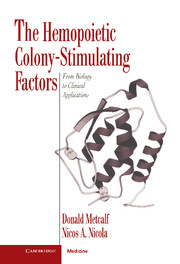Book contents
- Frontmatter
- Contents
- Preface
- 1 Historical introduction
- 2 General introduction to hemopoiesis
- 3 Key techniques in analyzing hemopoiesis
- 4 Biochemistry of the colony-stimulating factors
- 5 Biochemistry of the colony-stimulating factor receptors
- 6 Molecular genetics of the colony-stimulating factors and their receptors
- 7 Biological actions of the colony-stimulating factors in vitro
- 8 The biology of colony-stimulating factor production, degradation, and clearance
- 9 Actions of the colony-stimulating factors in vivo
- 10 Role of the colony-stimulating factors in basal hemopoiesis
- 11 Actions of the colony-stimulating factors in resistance to infections
- 12 Role of the colony-stimulating factors in other disease states
- 13 The colony-stimulating factors and myeloid leukemia
- 14 Clinical uses of the colony-stimulating factors
- 15 Conclusions
- References
- Index
Preface
Published online by Cambridge University Press: 04 August 2010
- Frontmatter
- Contents
- Preface
- 1 Historical introduction
- 2 General introduction to hemopoiesis
- 3 Key techniques in analyzing hemopoiesis
- 4 Biochemistry of the colony-stimulating factors
- 5 Biochemistry of the colony-stimulating factor receptors
- 6 Molecular genetics of the colony-stimulating factors and their receptors
- 7 Biological actions of the colony-stimulating factors in vitro
- 8 The biology of colony-stimulating factor production, degradation, and clearance
- 9 Actions of the colony-stimulating factors in vivo
- 10 Role of the colony-stimulating factors in basal hemopoiesis
- 11 Actions of the colony-stimulating factors in resistance to infections
- 12 Role of the colony-stimulating factors in other disease states
- 13 The colony-stimulating factors and myeloid leukemia
- 14 Clinical uses of the colony-stimulating factors
- 15 Conclusions
- References
- Index
Summary
Our objective in writing this book was to prepare an up-to-date account of the colony-stimulating factors - hemopoietic regulators that have now entered clinical use. We assumed that this could be accomplished with sufficient documentation in a book of moderate length with perhaps some 600 references. However, we were discomfited to find that, in the past decade alone, there have been more than 12,000 publications on the colony-stimulating factors, and we were forced to exercise a higher level of selectivity than originally anticipated. We attempted to acknowledge the work of others by broad referencing, but inevitably we are probably guilty of overreferencing our own studies, which have lodged more firmly in our memories. For this we beg the indulgence of our colleagues.
On one matter we have exercised deliberate bias. It happens that most of what we know about the biochemistry and biology of the colonystimulating factors was established first with murine systems and was only subsequently confirmed with human systems. We have noted a growing unawareness, particularly among our clinical colleagues, that this was so and have therefore written the account in a manner that makes the real sequence of discovery evident. The biology of mice and humans can differ significantly, but in most respects this is not the case for the colonystimulating factors, and any pretensions to be dismissive of earlier mouse studies must be firmly checked. Progress has resulted from a fruitful interaction between both groups of investigators, and we are therefore happy to dedicate this account to all of our colleagues and competitors in acknowledgement of their achievements.
- Type
- Chapter
- Information
- The Hemopoietic Colony-stimulating FactorsFrom Biology to Clinical Applications, pp. xiii - xivPublisher: Cambridge University PressPrint publication year: 1995

